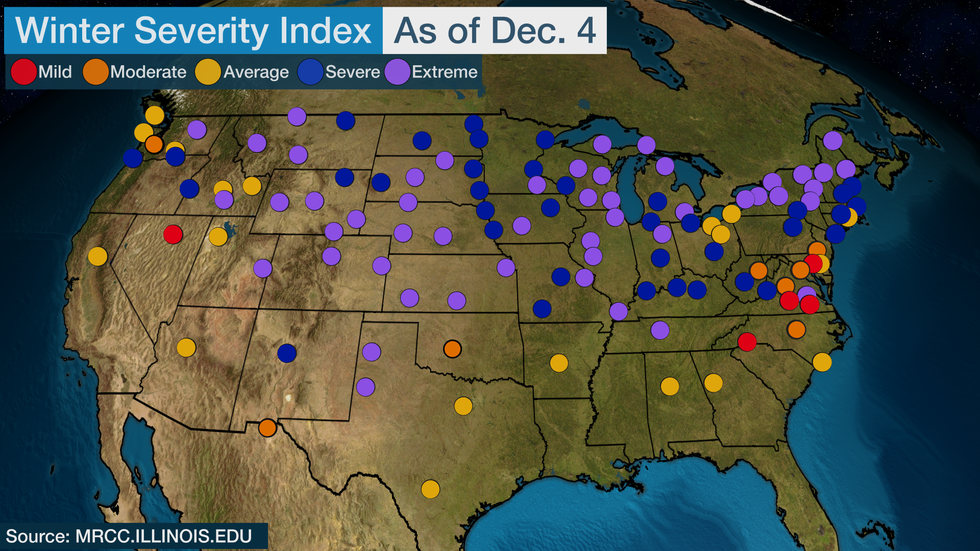Winter has started strong in several locations across the United States, and it's only the beginning of December.
Heavy snow has piled up in much of the northern tier of the U.S. Already, two locations in Montana have almost received their average annual snowfall. Havre, Montana, just needs 1.8 inches of snow to reach the total that typically falls during the entire season, July 1 through June 30. Great Falls, Montana, needs just over 3 inches to reach its seasonal average.
Both Havre and Great Falls have had more than four times the average snowfall to date. The heavy snow began at the end of September, when Great Falls picked up 19.3 inches and experienced one of its heaviest snowstorms of all-time. Additional rounds of snow have added to the totals over the past two months.
Not Just the Northern Rockies
Duluth, Minnesota, experienced its eighth-snowiest November, with a total of 27.7 inches, nearly double the November average of 14 inches. Almost 22 inches of snow fell during the post-Thanksgiving storm that crossed the country, named Winter Storm Ezekiel by The Weather Channel. This was one of the 10 biggest two-day snowfalls on record for Duluth. Due to this late-month snowfall, Duluth also tied the record for its greatest snow depth for Dec. 1.
Several other cities in the Great Lakes region have also seen well-above-average snowfall so far this season. This includes Green Bay, Milwaukee, Chicago and Detroit, all of which have picked up more than four times the average snowfall to date, with 20.2 inches, 13.7 inches, 8.4 inches and 9.6 inches, respectively. Detroit even set an all-time November snowstorm record on Veterans Day and the day after, Nov. 11-12, when 9.2 inches fell.
Parts of upstate new York and northern New England have also had an extreme winter so far, according to the Accumulated Winter Season Severity Index (AWSSI) from the Midwest Regional Climate Center (MRCC).
This index, also known as the Winter Misery Index, looks at the "intensity and persistence of cold weather, the frequency and amount of snow and the amount and persistence of snow on the ground," the MRCC says. There are five categories that range from mild to extreme; The extreme category indicates where the season is in the 99th percentile to date (the most extreme 1%).

Albany has totaled almost 25 inches of snow through Dec. 3, six times more than its average to date of 4 inches. Most of this snow fell in the first two days of December, courtesy of Winter Storm Ezekiel. This system dumped 22.5 inches, making it the city's eighth-heaviest snowstorm on record.
Rochester, New York; Burlington, Vermont; and Caribou, Maine, have also seen more the double the average snowfall to date.
Honorable Snow Mentions
A few locations in the South also have seen a relatively strong start to winter. Amarillo, Texas, measured 5.5 inches of snow on Oct. 24, their heaviest October snowstorm in 101 years. Thunder and lightning accompanied the snow.
Other locations in the South that have already seen snow include Fayetteville, Arkansas; Knoxville, Tennessee; and Nashville.
The wet season started slowly in the Sierra, but the recent pattern has brought ample precipitation to the region. The National Weather Service in Reno noted that the Sierra went from almost no snow to far above average in a week.
Snow water equivalent – a measure of how much liquid is in the snow on the ground – is near or above average for most locations in the Sierra as of Dec. 3.
Not Just Snow
In addition to the above-average snowfall, chillier than usual conditions have dominated parts of the U.S. at times.
In October, record cold was widespread from the Northwest into the Rockies and Plains. Almost 20 larger cities in the West shivered through the coldest October on record. This included Rapid City; Spokane, Washington; and Grand Junction, Colorado.
In November, the cold shifted into the East, and most locations east of the Rockies were cooler than average for the month. It was the second-coldest November on record in Watertown, New York, and the third-coldest in Bangor, Maine.
The Weather Company’s primary journalistic mission is to report on breaking weather news, the environment and the importance of science to our lives. This story does not necessarily represent the position of our parent company, IBM.
The Weather Company’s primary journalistic mission is to report on breaking weather news, the environment and the importance of science to our lives. This story does not necessarily represent the position of our parent company, IBM.

No comments:
Post a Comment